Popular varieties of garlic
Garlic is one of the oldest agricultural crops. Central Asia is considered the birthplace of this plant, but it was cultivated in Ancient Egypt, Rome, and India. Today there are many varieties of plants that differ in planting time, shape, taste, yield. Consider the most popular varieties of garlic.
- Winter shooting varieties
- Alcor
- Sofievsky
- Podmoskovny
- Gribovsky
- Komsomolets
- Bogatyr
- Flight
- Azure
- Benefit
- Grigory Komarov
- Casablanca
- Zemyay
- Petrovsky
- Stallion
- May VIR
- Belorussian
- Winter non-shooting varieties
- Dobrynya
- Hermidor
- Messidor
- Bogolepovsky
- Hermann
- Spring varieties
- Gulliver
- Sail
- Odessa
- Flavor
- Flower
- Universal varieties
- Ukrainian white
- Elephant garlic
- Family garlic
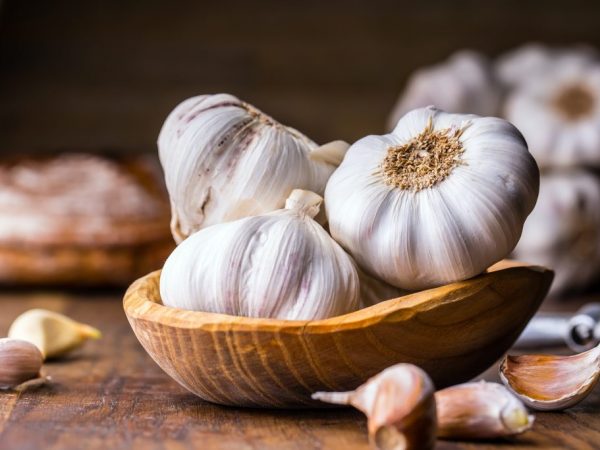
Popular varieties of garlic
Winter shooting varieties
Winter varieties are planted in the soil in the fall, when their root system begins to develop. In winter, a dormant period begins, and the main growth and development of the plant occurs in the spring. The collection of culture is carried out in the summer. Consider the arrowed types of winter garlic.
Alcor
The Alkor variety is characterized by frost resistance and is recommended for planting in the northern regions of Russia. It is an arrowhead plant with a yield of 3.5 kg. The head of Alcor consists of 4-5 rather dense pink teeth with noticeable purple veins. Bulb weight often reaches 36 g. Alcor is an acute species, resistant to viral diseases.
Sofievsky
Sofievsky, like the White Swan variety, is frost-resistant, well preserved and has excellent taste, for which it has gained high popularity in cooking. The head of Sophia garlic has a rounded, slightly flattened shape, it is white with pink veins. It can contain 5-7 cloves, each weighing up to 18 g. The yield of the Sofievsky vegetable ranges from 1 kg to 1.8 kg, depending on the period of its cultivation.
Podmoskovny
Considering varieties of winter garlic for planting in the Moscow region, one cannot fail to mention the variety, which is called 1 Podmoskovny. It is a frost-hardy arrowhead plant with excellent resistance to many infectious diseases. The head of Moscow Region garlic consists of 5-7 cloves, each weighing about 10 g. The plant yield is 1.5 kg, the taste is spicy.
Gribovsky
Considering the best varieties of garlic, one cannot fail to mention the Gribovsky variety, which is perfect for growing in the north-western region. Due to its rapid maturation, rapid formation of arrows and good resistance to diseases, Gribovsky is very popular among gardeners. The head of the plant is characterized by a rounded shape and purple veins on the scales. It can have from 5 to 10 cloves and usually weighs about 60 g. The yield of Gribovsky, when grown correctly, reaches 3 kg or more.
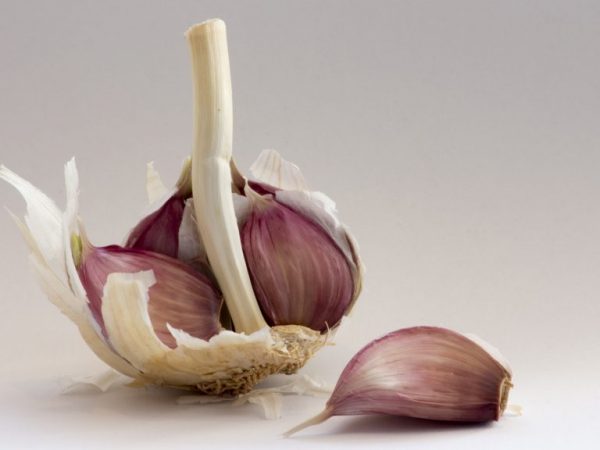
Purple garlic
Komsomolets
Komsomolets is a winter garlic variety that is resistant to winter frost. According to the taste characteristics, Komsomolets is classified as a rather spicy species, and in terms of the size of the head, it is classified as large.The average weight of the head of the Komsomolets is 100 g. The plant bulb usually has 6-13 cloves. The yield of this culture reaches up to 1.5 kg.
Bogatyr
The high-yielding variety of winter garlic Bogatyr is characterized by a large head with 5-7 cloves. Its average weight reaches 85 g. The scales covering the teeth have a purple hue. A distinctive feature of the plant is the good preservation of the crop.
Flight
Flight also applies to winter crops. It is a medium-ripening arrowhead plant with a large head. As a rule, it has a flat-round shape and consists of 5–6 denticles. On average, the weight of the bulb is 40 g. The flight is classified as an acute species.
Azure
Azure is a mid-season arrowhead plant with a shelf life of 5-6 months. Its average yield reaches 700 g per 1 sq. m area. The bulb of the plant consists of 5-6 cloves with white pulp, a pungent taste and a mass of about 60 g. Externally, it is covered with dry scales of a lilac shade with anthocyanin stripes.
Benefit
Benefis was bred in Romania in 2012 and almost immediately received international recognition due to its good keeping quality (up to 9 months), high yield and unpretentious cultivation. The bulb of the plant consists of 4-7 cloves and has a flat-round shape. With timely disembarkation and proper care, the head can weigh up to 170 g.
Grigory Komarov
Despite the relatively recent appearance, the Grigory Komarov variety is gaining more and more popularity every year. It is a winter, high-yielding, shooting crop with good keeping quality. The ripening period of this species is within 120 days, and the number of cloves in the head reaches 6 pieces.
Casablanca
Among the developments of Dutch breeders, the Casablanca variety deserves special attention. Its advantages are high yield, disease resistance and good keeping quality. The head of the plant is white and consists of 8–12 pink-beige cloves. You need to plant a crop for the winter, from September to November, and harvest in July.
Zemyay
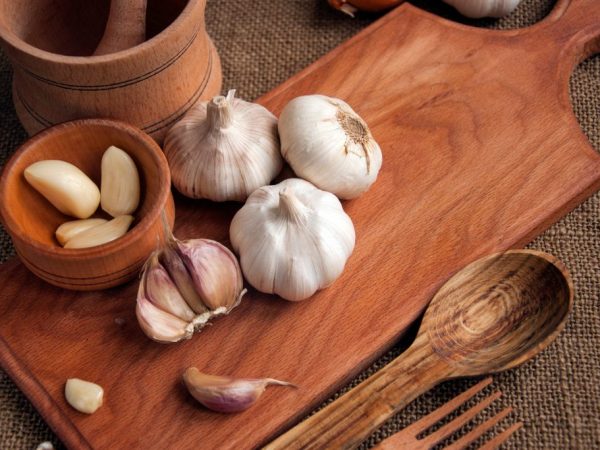
Garlic heads of different sizes
The characteristics of the Lithuanian selection called Zemiai are as follows:
- mid-season variety;
- the bulb is large, round;
- head weight - 60-80 g;
- the number of cloves - 6-8;
- the shade of the scales is yellow-violet;
- the height of the flower arrow is more than 1.5 m.
Petrovsky
The winter arrow-headed Petrovsky variety is characterized by a flat-round large head, the weight of which reaches 85 g. The bulb usually consists of 5-8 cloves. The color of the scales is dominated by a dirty gray color with visible purple veins. The yield of this culture is more than 1 kg per 1 sq. m.
Stallion
A mid-ripening shooter type of winter garlic Stallion has many undeniable advantages. It is resistant to dry weather and cold temperatures and is immune to the most common diseases.
The rounded-flat head of the plant consists of 5-7 cloves and weighs about 100 g. The color of the scales is white with brownish-purple veins. This culture is classified as a high-yielding one, since from 1 sq. m of planting area, up to 2 kg of bulbs are harvested.
May VIR
May VIR is an early plant. It is better to plant it for the winter. The head of the Maisky variety has a flat-round shape and a dense structure. The color of the scales of the plant is light purple. The number of cloves in an onion can be up to 15 pieces. They are quite dense, not too pungent in taste.
Belorussian
The Belarusian variety was bred by Belarusian breeders for cultivation in central Russia, the Kuban, Belarus and Ukraine. The plant is characterized by an average yield and a head weight of up to 80 g. Culture propagation is possible in three ways:
- Sowing plant bulbs (air).
- Sowing "one-tooth", which ripen in one season from air bulbs.
- Planting with teeth.
Winter non-shooting varieties
In addition to shooting winter varieties of garlic, there are also non-shooting garlic.This type of plant does not produce seeds and reproduces only by its cloves. These include the varieties Dobrynya, Germidor, Messidor, Bogolepovsky, German.
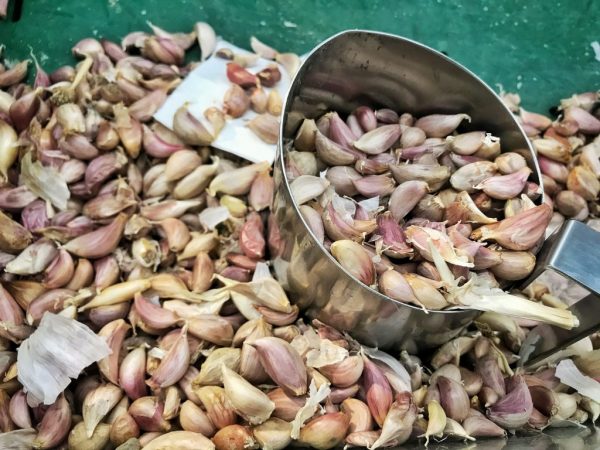
Many varieties are planted in winter.
Dobrynya
The variety of non-shooting garlic Dobrynya belongs to high-yielding (up to 2.5 kg) frost-resistant crops with good keeping quality. On average, the weight of the bulb reaches 55 g. This type of plant is widely used in cooking and for canning homemade preparations. Dobrynya has only one drawback - drying out and rotting during long-term storage.
Hermidor
According to the description of the Germidor garlic variety, it was bred by Dutch breeders as a non-shooting frost-resistant crop. The yield of Germidor garlic can be up to 500 kg from one hundred square meters. The bulbs of the plant are large enough and consist of 12-16 cloves, and their integumentary scales are painted in a violet-lilac color similar to the Romanov onion.
Messidor
The Messidor garlic variety, along with the Theodor and Benador species, was bred relatively recently, but has already won love and recognition among gardeners. The head of Messidor garlic consists of 10-15 teeth, the pulp of which has a slightly yellowish tint. The plant is non-shooting and has good winter hardiness. The mass of the head reaches almost 115 g. The variety has a good yield (up to 500 kg from each hundred square meters).
Bogolepovsky
One of the most popular new types of garlic developed in Russia is Bogolepovsky. This is a mid-ripening non-shooting plant, the yield of which is up to 2.5 kg per 1 sq. m landing. This type of garlic has a round, slightly flattened head, consisting of 12-14 cloves of a simple structure.
Hermann
German belongs to mid-season winter crops. The weight of its head reaches 50 g, it consists of 6-7 large denticles. The pulp of the plant has a creamy color and a pungent taste. The average crop yield is approximately 1 kg per 1 sq. m area.
Spring varieties
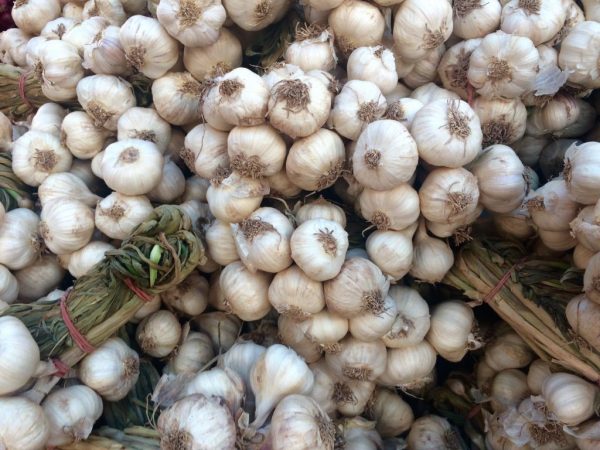
Summer garlic is less productive
Spring varieties of garlic are planted in spring and harvested closer to autumn. In winter frost conditions, they do not survive. In addition, spring crops are usually significantly inferior to their winter counterparts in terms of yield.
Gulliver
Among the spring varieties of garlic, Gulliver rightfully occupies one of the leading positions. The popularity of this plant is due to its resistance to various diseases, high yield and good keeping quality. A Gulliver bulb usually consists of 4-5 cloves. Its mass can reach 120 g, and the yield exceeds 1 kg per 1 sq. m landing.
Sail
When considering non-shooting spring varieties of garlic, Parus stands out. It has good keeping quality and high yield. The grayish-brown bulb of the plant has a rounded shape and can contain from 4 to 8 cloves. The average weight of a ripe head is 40 g.
Odessa
The Odessa variety of garlic is also referred to as spring. Non-firing plants of this species are characterized by the presence of a round-conical bulb with 8-9 teeth of different size and weight. The total weight of the head usually does not exceed 30 g. The taste of the pulp can be described as not very spicy.
Flavor
The creation of French breeders, which is called Flavor, is added to the list of elite types of garlic. This is a spring non-shooting plant that does not tolerate cold weather. The weight of the head is 18 g, and the scales on it are painted in a pale pink color. The teeth on the head are arranged in 2 rows, and the inner teeth are slightly smaller than the outer ones. The total number of cloves is 15-20.
Flower
Flower is a late perennial garlic variety. Its yield is 1 kg 200 g from each square. m landing. The mass of the head reaches almost 80 g. The plant bulb has a rounded shape and consists of 8 cloves. Dry scales of this type of garlic are painted in white-lilac color.
Universal varieties
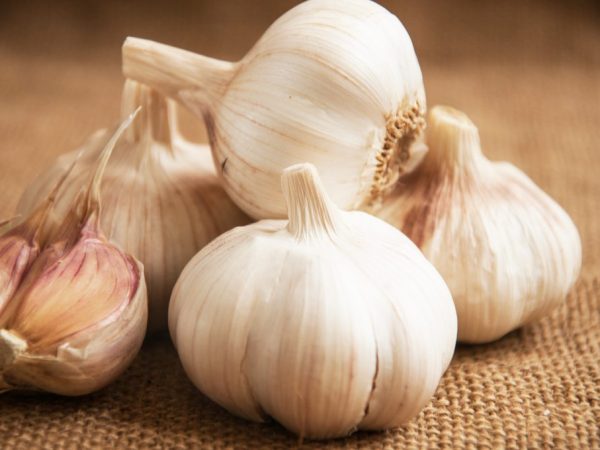
Ukrainian white garlic is planted at any time of the year
In addition to winter and spring varieties of garlic, there are those that can be planted both in autumn and spring. These include Ukrainian White, Elephant and Family Garlic.
Ukrainian white
The Ukrainian White variety was developed in Ukraine in the Zaporozhye region. This mid-ripening non-shooting species is characterized by good keeping quality and high productivity. The Ukrainian white bulb has a flat-round shape. The number of cloves of this plant reaches 20 pieces, and the weight of each of them is on average 12 g. The total weight of the head is 140 g.
Elephant garlic
Among all varieties of garlic, the large-fruited Elephant has a special place. This giant has several names: Elephant (or Elephant, as it is called in the West), Egyptian onion, Spanish or Elephant garlic, Rocambol. At its core, this very large garlic is derived from leeks with a distinct garlic flavor.
The plant belongs to both spring and winter crops. It is better to plant it in the fall: in this case, the yield will be higher. Reproduction of the plant occurs with the help of cloves or baby bulbs. The growing season of the culture is 120 days, the weight of the bulb can reach 500 g.
Family garlic
One of the most convenient for amateur gardeners is the Family type of garlic. From one clove, from 5 to 30 heads of various sizes are obtained. The total number of bulbs is influenced by many factors. In terms of taste and useful properties, Family garlic is in no way inferior to ordinary garlic.


